Mapping the journey of a B2B customer is a handful. There are so many variables to keep in mind that it becomes overwhelming. A customer journey in B2B is longer, more complex, and has domain-specific touchpoints and stages that you should know before diving into mapping.
We didn't want to leave this stone unturned, so we came up with this guide on how to create a B2B customer journey map. Here, we will also cover the key differences between mapping customer journeys for B2C, B2B, and B2E. As well as some pitfalls you should avoid.
At the end, you will get free CJM templates to map the journey of your B2B customers. You will be able to download them in PDF, CSV, PNG, PPTX, or change them online.
Contents
What is a B2B customer journey?
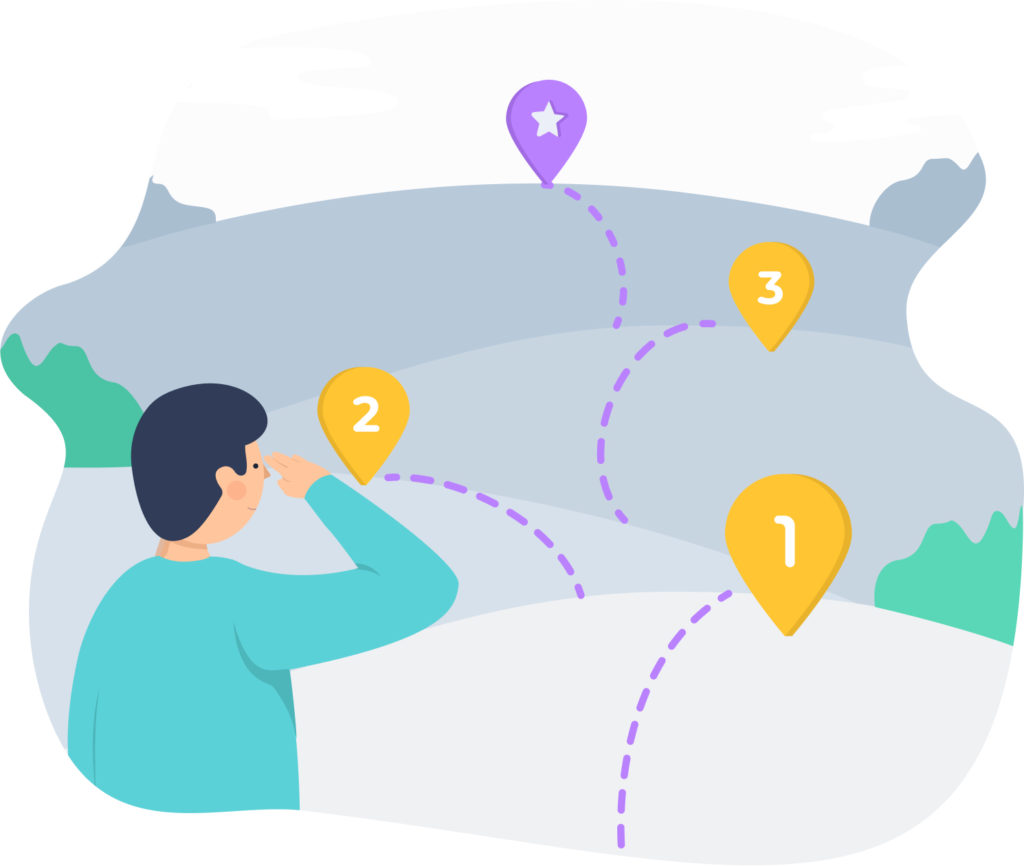
This journey represents the entire process a customer (a business in the B2B context) goes through when interacting with a brand, product, or service. It encompasses all the touchpoints and interactions occurring as a business progresses from being a prospect to becoming a customer and beyond.
What do such journeys look like in the real world? Here are some examples illustrating B2B journeys:
- A growing digital agency realizes the need to improve team collaboration and project management. They stumble upon an Instagram ad for a SaaS productivity platform and request a trial. Satisfied with the trial, they engage with a sales rep, who offers a customized plan that scales with the agency's growth. After a successful demo with the team, they purchase a subscription. Continuous support and new feature updates ensure the customer's loyalty and improve customer retention, and they eventually become advocates, referring other businesses to the platform.
- A construction company needs to buy new track loaders. The procurement manager visits a trade show and sees an exhibit that seems to match their needs there. The manager discusses equipment needs and financing options with a salesperson from the equipment manufacturer and then shares the information with the company’s management. Impressed by the product's capabilities and the flexible financing options, the construction company places an order. They receive operator training and maintenance support, ensuring a long-term relationship between the businesses.
- An aerospace parts manufacturer seeks to cut production time and costs. After discovering an industrial 3D printing service provider through an industry report, they initiate contact with the provider. The manufacturer gets a consultation, receives sample parts, and decides to engage in a pilot project. Its success leads to an ongoing partnership between companies.
The difference between B2C and B2B journeys
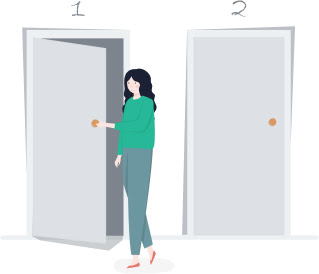
There are some critical differences between these B2C and B2B customer journeys, the major of which include:
The decision-making process
In B2C journeys, customers make decisions quicker compared to B2B ones. The difference stems from the number of stakeholders involved in the decision-making process.
- A B2C journey
A customer who visits a grocery store to buy some food for breakfast may be the only decision-maker. It will take them, say, twenty minutes to purchase a few groceries and go home. Suppose a customer has a partner, children, neighbor, parents, or someone else who may influence the purchasing decision. In that case, the shopping will take a little longer as the customer may consult with other people by, for example, calling, texting, or messaging them.
- A B2B journey
A medical facility decided to introduce a new service, and they are looking for a healthcare solutions provider to help them launch it. The clinic’s representative finds a healthcare manufacturer offering the required solution. But as other stakeholders (e.g., the finance department, chief surgeon, medical director, etc.) are involved in decision-making, each step toward signing a contract takes not minutes but hours or even days. And yes, there are many meetings, calls, and emails.
Journey length and complexity
Typically, B2C customer journeys are shorter than B2B ones. Let’s compare two similar journeys to spot the difference.
- A B2C journey
A couple seeking to rent a flat starts with searches on dedicated websites, filtering for their preferences. They quickly move to virtual tours and select a few flats to view in person. After several visits and considering aspects like location and price, they submit an application for their chosen flat. Following an approval process, they sign the lease, pay for the first two months, and move in, completing the journey from search to the new home.
- A B2B journey
A startup team that is in search of an office defines its requirements and hires a real estate broker to help them quickly find a perfect place for their rapidly growing team. The broker is actively searching for options. They visit several properties, weighing factors such as lease conditions and location against their budget and current and expected growth. After careful negotiation and legal review, they sign a lease and coordinate office setup before moving in.
The second journey doesn’t only sound complex, it’s really complicated. There are many decision-makers in the startup (and the person searching for the office isn’t one of them), some business-specific stages reflecting higher stakes, greater costs, and a longer sale cycle, and, on top of that, a lot of bureaucracy.
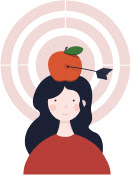
In B2C, customer emotions often drive purchasing decisions, along with price and convenience. In B2B, business needs, ROI, efficiency, and long-term value usually impact purchasing decisions more than emotions.
- A B2C journey
A consumer is choosing a new smartphone. They find two models with comparable features and prices, but one is endorsed by their favorite film star, who uses the phone in a series of stylish, upbeat ads. Despite similar specs on other devices, the emotional appeal wins, leading the consumer to purchase that particular smartphone.
- A B2B journey
A marketing agency is looking to streamline its client reporting process. They evaluate several analytics platforms and choose a service that not only integrates seamlessly with their existing data sources but also offers advanced AI-driven insights. In this case, the decision is driven by the need to deliver more comprehensive and intuitive reports to their clients and the desire to enhance their service offerings.
Touchpoints
Touchpoints in a B2B customer journey can differ from those in B2C because of differing customer expectations, sales cycles, and relationship dynamics.
For example, it’s quite typical for a business to get online demo sessions with a potential service provider before they even sign up for a trial period. On the contrary, a person on the fence about buying a subscription is more likely to create a free account in the platform first and start exploring it on their own before asking about trialing a paid plan.
How to create a B2B customer journey map
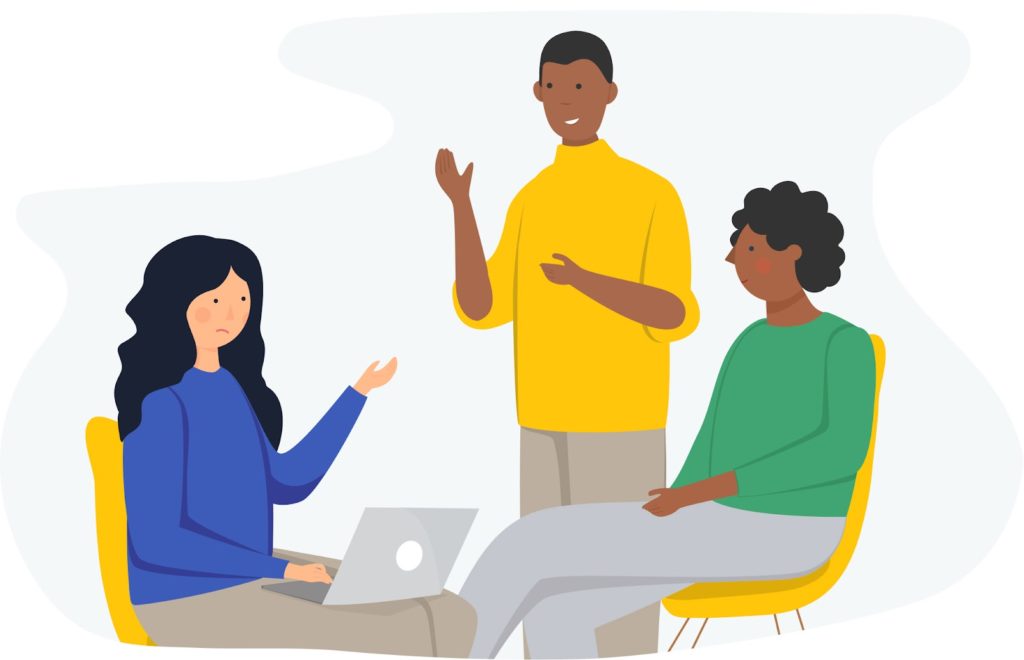
How to get started with B2B customer journey mapping? Follow these tried and tested steps:
1. Conduct a research
Researching a business market is so much different from researching a B2C. So, you have to pick a radically different approach here. Here are some points to keep in mind:
- Businesses are less open than consumers. You will have to convince them to share intel with you in most cases. If we take business-to-employee (B2E), then squeezing information about the employee experience and journey becomes close to impossible.
- B2B research has to be profound, so the hypothesis will not work here. However, given the previous statement, you will probably start with the hypothesis anyway.
- Due to a complex network of stakeholders from different departments, it is harder to define needs, pain points, and decision-makers.
- There's a larger geographical spread for B2B, so it's unlikely for you to have face-to-face interviews or focus groups.
💡 Tip: A considerably smaller sample size will make up for the pains mentioned above.
What information to collect
The nature of data you're going to look for the journey of your B2B customer is quite different from data for B2C. So, for the latter, you want to know your target audience's expectations, pain points, and motivations.
However, knowing expectations and pain points is not enough. Let's see what information you should collect during the research:
- Business model;
- Organization structure;
- Purchasing & other processes;
- Their customers and competitors;
- Levels of influence of each stakeholder;
- Hierarchy of needs.
Note that this is by far not the complete list. When researching, you should consider every detail that can impact the journey and lead you to priceless insights.
Sources of data
Finally, once you know what you are looking for and what to expect, it's time to identify what sources of information you will use. For B2B research, there are a couple of well-tried sources.
- CRM data;
- Phone interviews with existing customers;
- Online search;
- Existing knowledge from sales and customer relations departments.
Of course, options will vary depending on what kind of business and customers you have. But this is something you can start with.
2. Personas in the B2B customer journey
Having gathered all the information, you can move to the next stage: creating customer personas for your B2B journey.
The critical difference from B2C is the number of decision-makers you will have to deal with. Of course, if we're taking small or medium biz, it can be that just a couple of individuals make the decision.
But once we move one step up the ladder, the number of stakeholders starts to grow. You will have all sorts of representatives from different departments who will participate in the process of decision-making. Each will have their own expectations, demands, and pain points.
How to deal with complexity?
Making a corresponding persona for each stakeholder is probably the ideal option, but you can start with something simpler and more generic. For example, take the entire business and treat it as your persona.
The benefit of this approach is simplicity and speed. In a situation where there is no time to develop 10 full-blown personas, a "business" persona is a fine workaround. Once you have enough resources and data, you can start splitting it into separate personas.
Another approach you can take is to break down this hoard of stakeholders into groups. It can be:
- Informers — individuals who find your product and spread the word about it within their company.
- Decision-makers — the ones who decide whether they want to use your service or not.
- End-users — the actual people who will use your product.
The major challenge here is figuring out how much influence each party has.
Key differences
Business personas seem to be more rational than consumer personas. This isn't entirely true. People are irrational, and it's their nature. However, there are many constraints in business that make the process of decision-making less irrational.
So, if we take each stakeholder individually, we will see notes of irrationality. But, once they're in one room, they will have to appeal to rationality to come to a decision.
Also, if in B2C the buyer persona is often the end-user, customer journeys in B2B are a great example of a buyer vs. user persona division.
What to describe
Depending on the type of a particular persona, you will want to pay attention to different things. Thus, for informer personas, you will want to pay special attention to the information channels they use. As for decision-makers, you will want to focus on their higher-level goals and pain points.
But the trickiest part will be to map all relations between each party to figure out whether informers and decision-makers are the end-users as well. Or how much influence informers have on end-users or buyers have on the decision-makers. You may even create a separate section in your persona profile for this.
💡 Tip: Using empathy maps in B2B is also a bright idea, as it can help you better understand stakeholders.
3. Visualize the journey with processes, actions, and interactions
With B2B personas in place, you can proceed to mapping out their journey. We recommend starting with defining the stages your personas move through.
Then, determine sections to include in the map. Common sections include customer goals, touchpoints, processes, channels, problems, and improvement ideas. Put together, B2B journey stages and map sections will make up a map skeleton you can fill with data to represent your B2B customer experience.
As you already know, in B2B, not only are customer journeys longer, but they are also often more complicated, considering the number of people taking part in the process.
Now, let's look at some aspects of a customer journey in B2B and B2E and how those are different from a typical consumer journey.
B2B customer journey stages
Unlike it is for customer journeys in B2C, stages for a B2B or B2E customer journey have some extra steps that you don't want to miss. They are critical to the entire journey and can be so-called moments of truth.
So for a typical consumer journey, we have stages like ‘Aware’, ‘Research’, ‘Consider’, ‘Buy’, and ‘Use’. Here's what a B2B one would look like:
- Aware;
- Research;
- Contact & Request a Demo;
- Demo;
- Consider;
- Make a Decision;
- Contract Negotiations;
- Delivery & Integration;
- Use;
- Support;
- Feedback;
- Advocacy.
And this isn't the entire list. Depending on your business and your customer or buyer expectations and processes, there might be stages like ‘Trial’, ‘Conducting an audit’, ‘Legal procedures’, and so on. At some point, they can fork, loop, or go back. For example, a legal issue at the ‘Contract Negotiations’ phase may push the whole process back to the ‘Consideration’ stage.
To make it all worse, different decision-makers will come into play during certain stages, and they will have a serious influence. Well, that is obvious. But, and there's always a but: at some particular stages, there will be multiple decision-makers having quite the opposite opinions. For instance, before deciding, an IT director is happy with how your product fits in the current infrastructure, but the legal procurement team has their doubts.
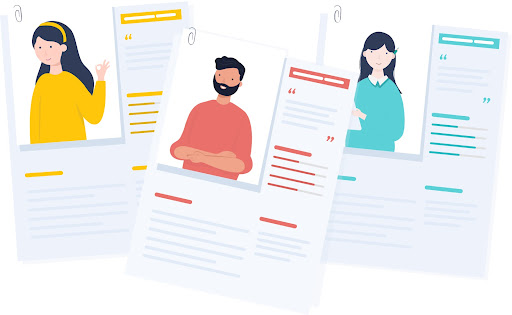
To minimize risks (if that's remotely possible), you can mark stages and phases where the interests of different parties intersect. This way, you will know where you need to go the extra mile in order for the journey to be less bumpy and your chances for success a lot higher.
B2B customer journey touchpoints
There are a number of B2B customer touchpoints to consider when mapping your customers' journey. And not just because businesses may use different approaches and channels when looking for solutions. Which they do. Here are a couple of B2B customer journey touchpoints you can find in your case:
- Getting a product demo;
- Participating in sales meetings;
- Attending business conferences;
- Getting business proposals;
...and a whole bunch of others. No matter how many touchpoints you find, all of them must end up on your map.
4. Take action
What to do next once you’ve built the journey map?
Synchronize
Mapping a B2C customer journey alone isn't particularly easy (not to mention it's not even effective) but doable. Being a lone ranger while mapping a B2B journey is just insane and counterproductive.
Ideally, you should involve representatives from all teams across your entire company. Front-line staff, back-end folks — everyone. If it's not possible to let them participate in the process of mapping, at least make sure they can look at the complete map.
Read also: Who should own customer journey mapping in your organization?
Apply
Your map should not end up collecting dust on a shelf. It must be put to the test right away. Whether you come up with a list of ideas, features, or recommendations, a map must work for you. Not the other way around.
💡 Tip: Introduce customer journey metrics to track. Having them on your map, your team will be more inclined to use it.
Update
And, of course, mapping the journey of a B2B customer isn't a one-time activity. It is a process that, once started, must go on for as long as your company functions. So, depending on your case, make sure you always get back to your journey map and update it according to the new data, changes in your company's internal processes, or changes happening in the market.
How to improve your customer journey for B2B
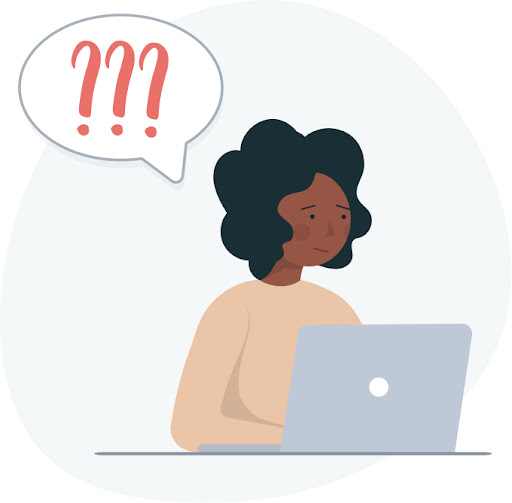
There are no easy steps to improve your customer journey once and for all. Although B2B journeys will have much in common, each journey has its specifics.
Creating a map of your B2B customer journey is the first step toward improving this journey. Working on this asset, you will get a deeper understanding of your B2B customers, their needs, motivations, goals, and so much more.
You will also learn what happens at each stage. You will know for sure where you shine and where are issues that need to be addressed to improve your B2B client experience.
Yet, there are some common B2B journey issues that may be relevant to your journey. So be sure to check whether you have them when doing mapping:
- Touchpoint inconsistency: you interact with prospects through many different channels, which leads to inconsistencies in messaging or experience, ultimately confusing prospects and leading to a disjointed customer journey.
- Insufficient personalization: today, even businesses expect personalized experiences.
- Ineffective account management: your customers may expect a deeper understanding of their business from you.
- User experience issues related to the usage of your website, web app, platform, mobile app, etc.
- Poor onboarding and customer service. Inadequate training, insufficient support, lack of regular check-ins, or neglect of feedback can make customers feel undervalued or frustrate them.
B2B customer journey map templates
And just as I promised, I am sharing some examples of B2B customer journey maps.
- Example 1: Banking
This template, which includes both a B2B customer persona and a journey map, focuses on the journey of a business owner who wants to subcontract payroll processing to a bank.
- Example 2: Bespoke manufacturing in healthcare
This B2B journey map describes the journey of a medical facility that is looking for an orthokeratology supplier to expand its offering. There are many personas involved in the journey, and their interactions are visualized in a dedicated section.
- Example 3: SaaS
It’s another example of a customer journey with multiple personas. The key actor is a representative of an IT company who is looking for project management software.
These and other B2B journey mapping templates are absolutely free to use and available in our template library. Make sure you check them before you start your next B2B CJM project! 😉
Final word
As you can see, mapping a customer journey map for a B2B case is a tough row to hoe. But once armed with our tips and tools, it's pretty manageable. Speaking of tools, UXPressia has quite a handful of those suited for all possible journey map scenarios. With our Customer Journey Mapping tool, you can create, update, share, and export all your journeys (and personas!) in a matter of minutes.
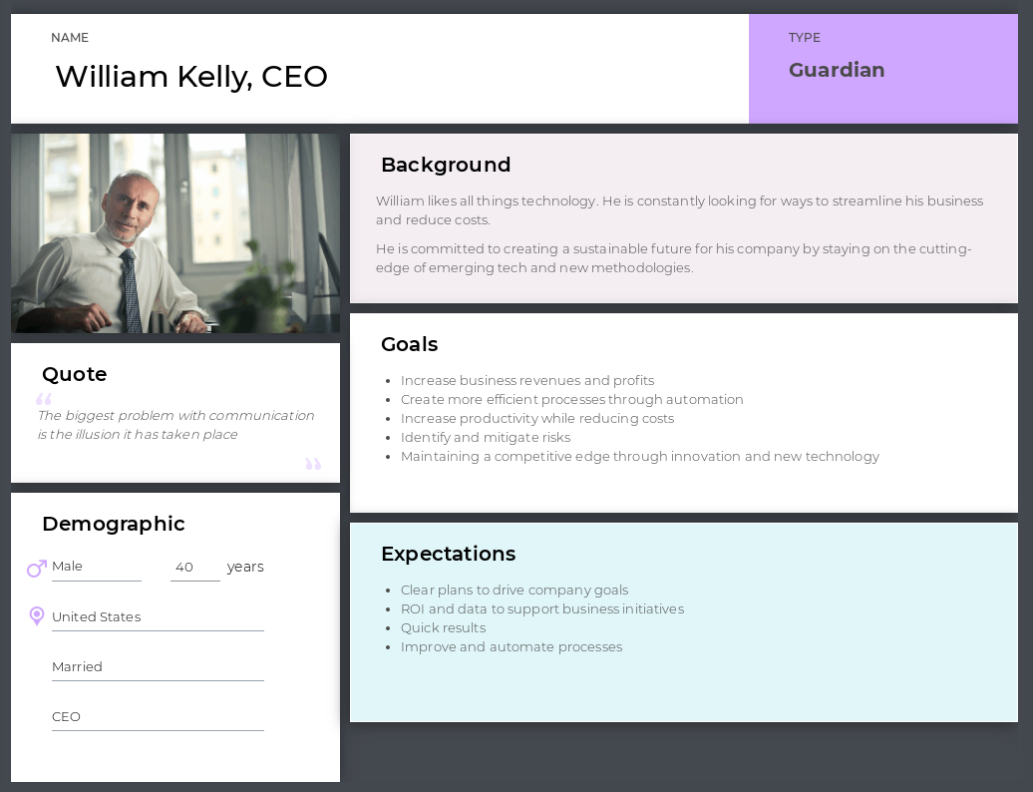
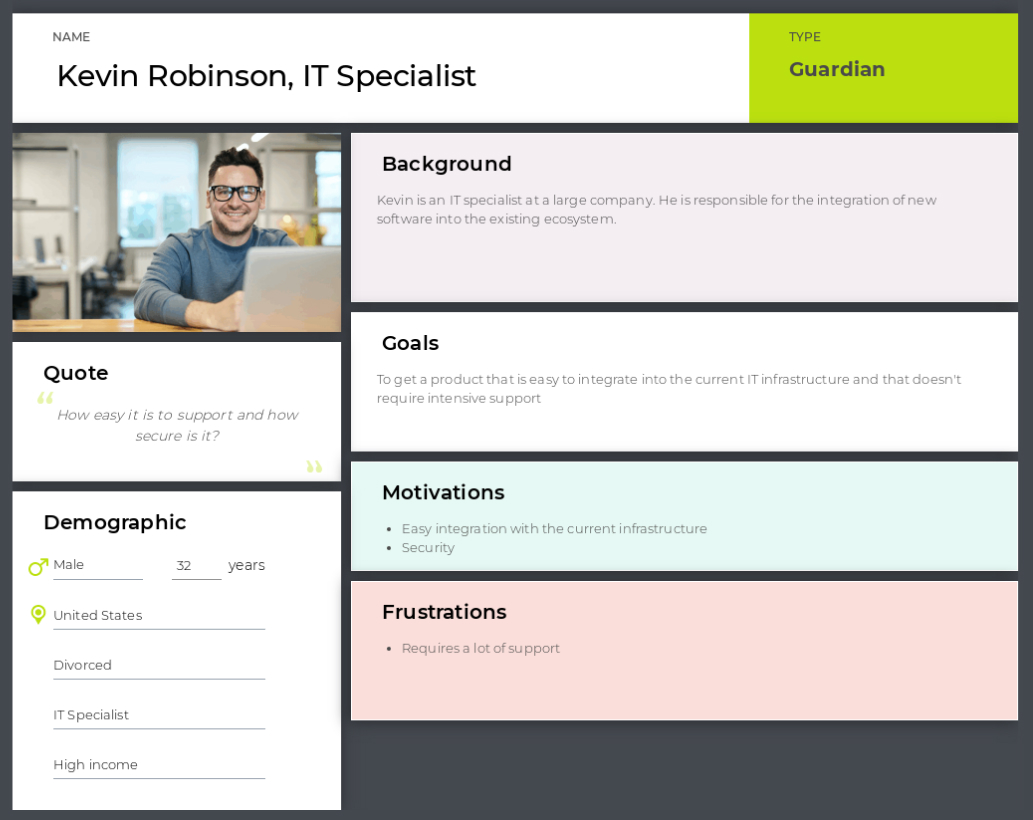
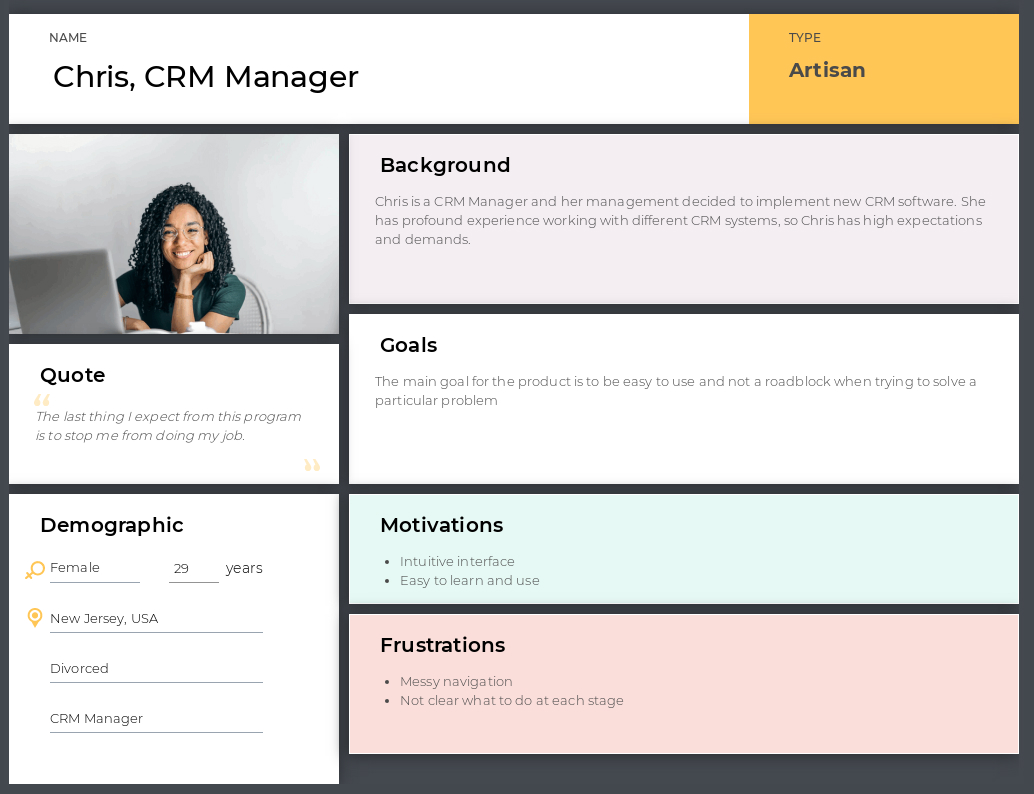

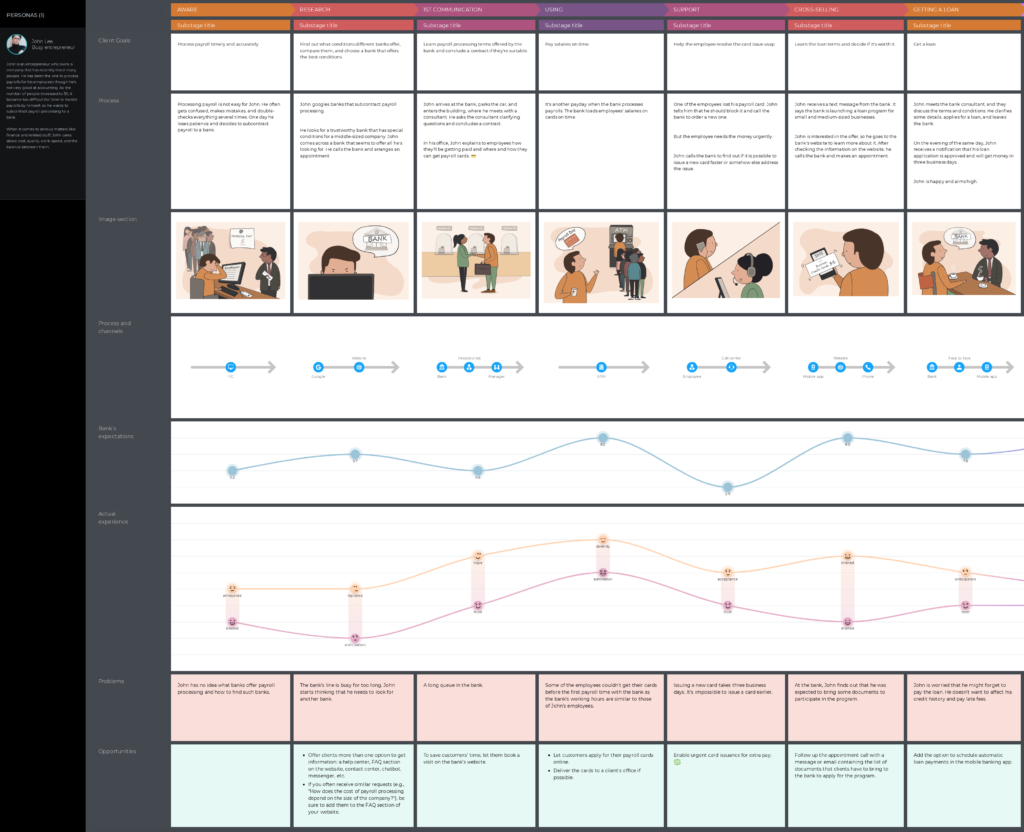
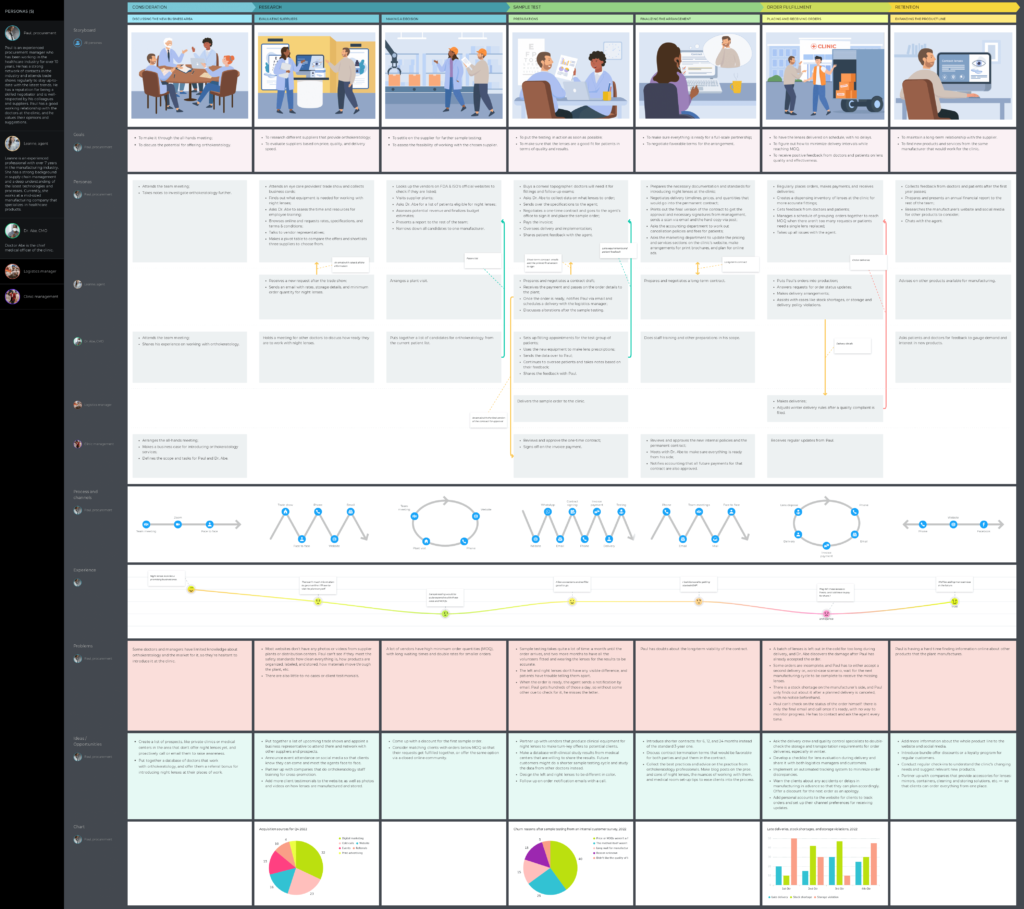
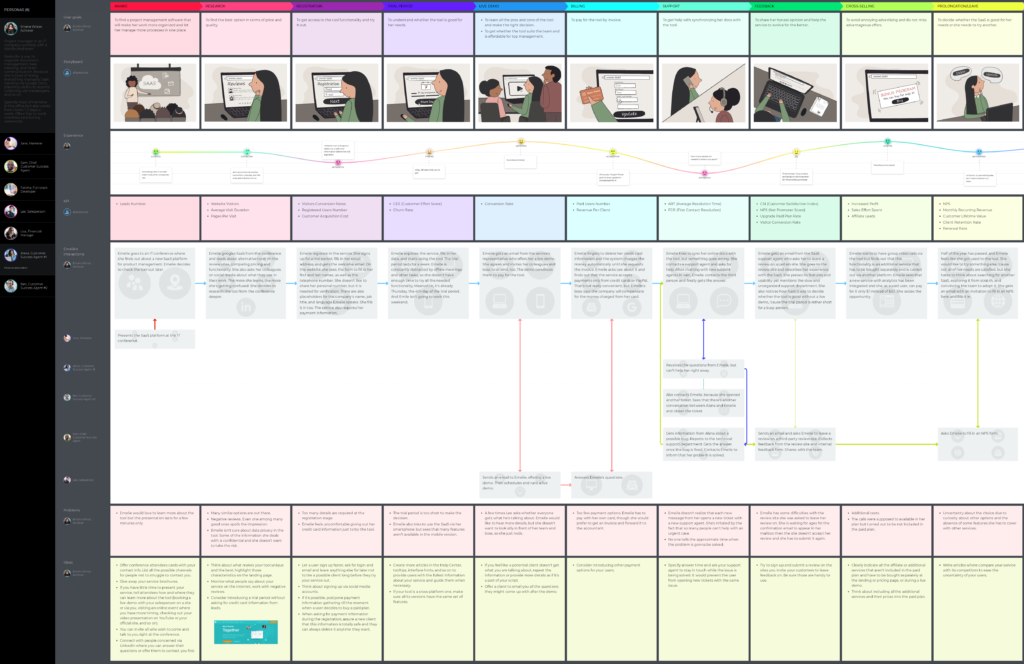


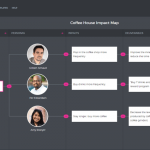



Would just like to add that detailed, well-researched personas are essential for B2B customer journey mapping. It’s not like they aren’t important to B2C as well, but when you think of a business, the end user is often not a decision maker. Like it’s up to the CTO to choose a SaaS, the CFO has to approve of the purchase, and a regular employee will be the one working with it. So three different grounds to cover, with different aspects to focus on.
Was wondering how to create a b2b customer journey map for an insurance company. Came across this article. A good general outline, a question though: do you have something that is insurance-specific? Thanks
Hi Jed, sure! We have several pre-filled insurance templates that you can view and download right here: https://uxpressia.com/templates/banking-finance-and-insurance
They come with industry-specific channel icons, B2B customer journey touchpoints, and B2C examples for different cases.